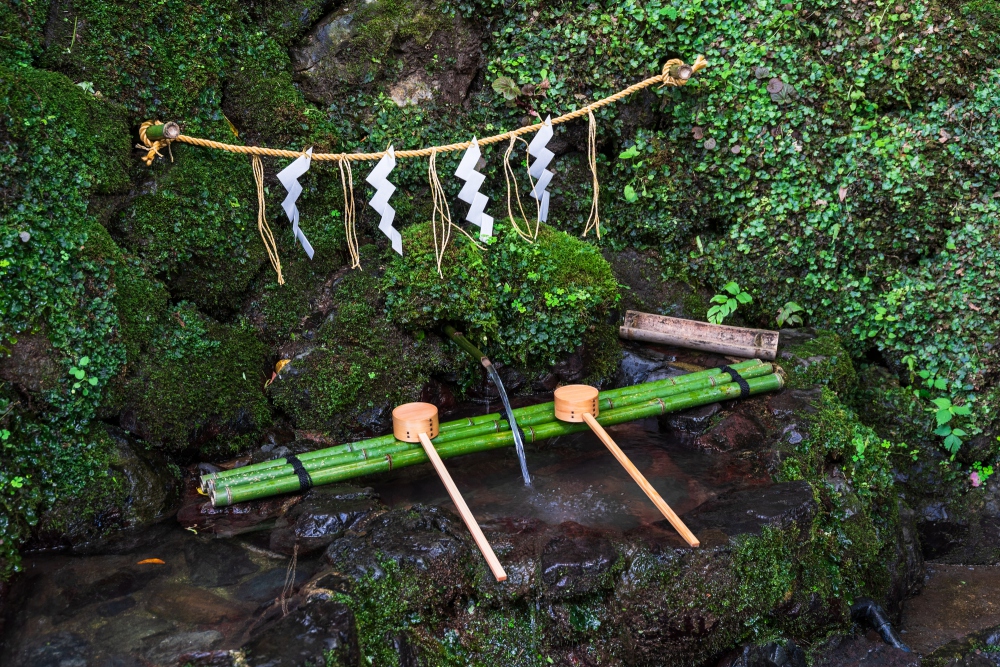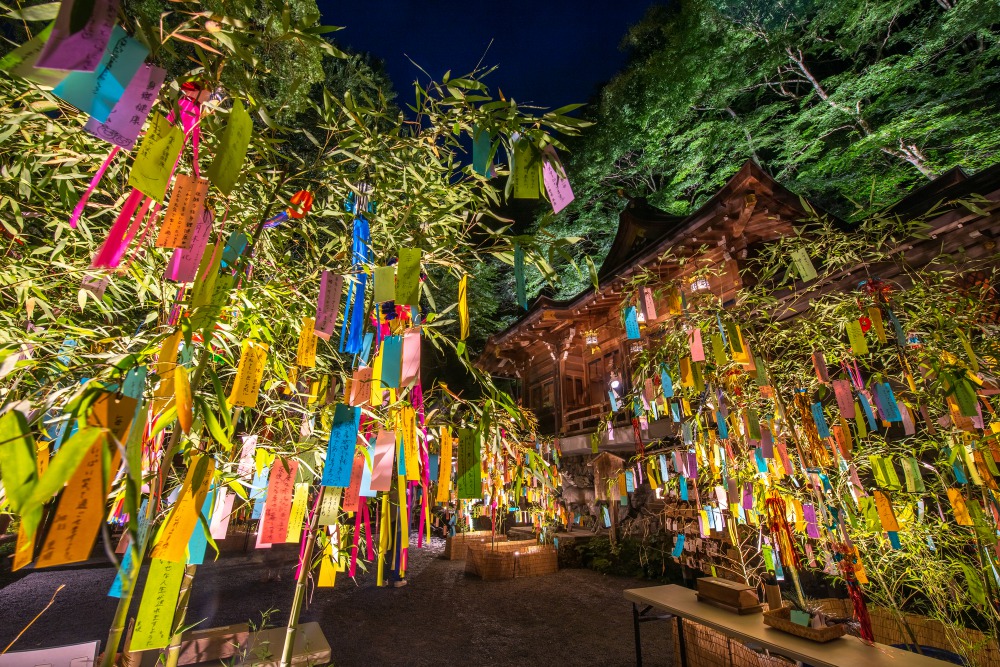Kyoto’s Kifune Shrine (貴船神社, Kifune Jinja) has been long worshipped as the shrine that protects Kyoto’s waters. The shrine is also known for its matchmaking powers, and its unique omikuji (fortune telling slips).
Kifune Shrine’s stairway that are lined with vermillion lanterns on both sides make for a beautiful landscape in every season. Here are some sights at Kifune Jinja Shrine that you can’ miss.
About Kifune Shrine

Torii gate at Kifune Shrine's entrance
Kifune Shrine (貴船神社, Kifune Jinja) locates at the foot of Mount Kurama, where the Kamogawa River originates. It is the main Kifune Shrine out of the 450 sub-shrines it has nationwide.
When exactly the shrine was built is unknown, but it is said to be at least 1,300 years old.
Kifune Shrine as a lucky spot
Kifune Shrine is known to be one of the luckiest and most spiritual spots in Kyoto.
A long, long time ago, “Kifune” (貴船) was written differently from how it is today, as “氣生根” (read the same). Those three characters meant the source (根) of power (氣) for all living (生) things. Because of this, it is said that Kifune-jinja is home to the god of rising power and luck.
“Kifune” vs. “Kibune”
Kifune Shrine is located in the town of Kibune, both of which are written in the same Chinese characters. What seems like a trivial, yet unnecessarily confusing difference actually has an intentional reason.
Originally, the town name and shrine name were both “Kibune”. However, since the shrine is dedicated to the deities of water, the clearer, cleaner pronunciation of “Kifune” was given to the shrine.
The Deity of Kifune Shrine

The water deity of Kifune Shrine
Kifune-jinja enshrines Takaokami-no-kami, the deity who controls water. To protect Kyoto's waters for the people's livelihoods, rain-controlling rituals have been dedicated through the ages to this deity.
Omikuji (fortune telling slips) are common and available for purchase at almost any shrine, but the ones at Kifune Shrine are a little bit unique. The omikuji here are called the “mizu-ura mikuji”, and involves the usage of water.
 Mizu-ura mikuji at Kifune Shrine
Mizu-ura mikuji at Kifune Shrine
After purchasing the fortune telling strip, head to the Mizu-ura-yuniwa stream, where the Shrine's holy water is running. Place your omikuji on the water, and you will see the words appear on the paper.
It is said that the water deity of Kifune Shrine is able to see through all things, and Kifune Shrine's omikuji reflect this by being very accurate.
You can drink the holy water here for free, and even take it home with you. The water is said to have never stopped running. It is low in alkali and is from a fresh spring.
However, since the water is completely unfiltered, it is better drank as possible or boiled once before drinking it. If you don’t have a bottle with you, you can purchase one at the shrine for ¥300.
Kifune Shrine is the Origin of "Ema"

Statues of the horses
Kifune-jinja is also where ema originated. Ema are the wooden votive plaques you see commonly at Japanese shrines. People write their wishes on them and hang them up at the shrine.
During the Heian Period (794 – 1185), the emperor used to use horses for water-related prayers. To pray for rain, he sacrificed a black horse. To pray for the rain to stop, he sacrificed a white horse. Eventually, he began using the wooden plaques instead of real horses, and that is said to be the beginning of the ema tradition.

Ema
There are three ema designs to choose from at Kifune-jinja: a horse one, a dragon one and one with a painting of Izumi Shikibu, a poet from the Heian period.
Praying at Kifune Shrine
There are three prayer halls at Kifune Shrine: the Honmiya, Okumiya and Yui-no-yashiro. They are to be visited in that order, and visiting all three is called “Sansha-mairi 三社詣”. Completing the “sansha-mairi” is said to make your wishes come true.
The Main Shrine: "Honmiya"

The Honmiya of Kifune Shrine
The first prayer hall is the main shrine, or "Honmiya". The hall you see today was made in 2005, which marked the 950th anniversary of the Honmiya’s move to its current location. It is built in a typical shrine style, called “nagare-zukuri”, and enshrines the deity of water, Takaokami-no-kami.
The Back Shrine: "Okumiya"

The Okumiya of Kifune Shrine
The Back Shrine, or "Okumiya" locates about a 5-minute walk away from the Honmiya. It is said to be where the shrine originated, and also enshrines Takaokami-no-kami.
There is a legend that a giant hole, called “ryu-ketsu”, exists right under the Okumiya, but no one is allowed to look into the whole. The Okumiya is said to be the most spiritual spot in all of the shrine grounds.
The Shrine of Bonding: "Yui-no-yashiro"
 Yui-no-yashiro
Yui-no-yashiro
The Yui-no-yashiro can be found in between the Honmiya and Okumiya. It enshrines Iwanaga-no-himemikoto, the Japanese deity of "en-musubi" (general "matchmaking" between lovers, friends, and opportunities). Ever since the Heian period, Yui-no-yashiro has been known for its blessings of this matchmaking, and it has even been nicknamed the “shrine of love”.
The Seasons at Kifune Shrine
Kifune-jinja is beautiful throughout all four seasons.
Spring
Although there aren’t many cherry blossom trees at Kifune-jinja, there are some in the woods surrounding it. The cherry blossoms can be seen the best from Ryusenkaku in Honmiya.
Summer

Summer at Kifune-jinja
Entering the summer months, Kifune-jinja’s surrounding becomes greener and greener. At the beginning of summer, the shrine surroundings are a fresh, vibrant green, and later transitions into a deeper, dark green in mid summer.

Tanabata light-up
To celebrate the Tanabata festival, Kifune-jinja holds a Tanabata light-up event. During this time, the lanterns light up, too.
Autumn

Fall foliage at Honmiya
Kifune-jinja is well known as a fall foliage spot. The leaves begin changing color around early November. The countless maples on the shrine grounds turn into a deep, rich red, and are beautiful to look at, especially from Ryusenkaku.
During the fall season, a light-up event is held. In 2018, the light-up is scheduled to be held between Nov. 3 and Nov. 25.
Winter

Snowy Kifune-jinja
Winters at Kifune-jinja can get pretty snowy. Together, Kifune-jinja and snow create a view that cannot be found elsewhere. The view is especially stunning on the stairway.

Kifune-jinja light-up
Between January 1 and February 28, there is a special light-up event held only on snow days at Honmiya. Whether the light-up will be held or not will be announced at 3:00p.m. on Kifune-jinja’s official social media, so make sure to keep checking if you want to see the light-up.
Access
Nearest station: Kibuneguchi Station 貴船口
From Kibuneguchi Station
【Kibuneguchi Sta.】Kyoto Bus 33 / for Kifune
→【Kifune Bus Stop】about a 5-minute walk
Visit Kifune Shrine to Receive its Divine Energy!
Kifune Shrine is known widely for its love deity and the blessings she grants to romantic relationships. However, it is also said that her powers can bring you to all kinds of fateful encounters such as with business opportunities, childbirth, and education. If you are in Kyoto, it might just be worth your time to stop by for a divination!
Information
180 Kurama-kibune-cho, Sakyo-ku, Kyoto-shi, Kyoto
075-741-2016
〈Shrine Opening Hours〉 May 1 to Nov. 30: 6:00a.m. - 8:00p.m. Dec. 1 to Apr. 30: 6:00a.m. - 6:00p.m. 〈Offerings〉 9:00a.m. - 5:00p.m. *Jan. 1 to Jan. 3: closes at 8:00p.m. *Extended hours during light-up period
Open year-round
Free
http://kifunejinja.jp












_600x400.jpg)















_600x400.jpg)


